Home > About Us > Sustainability Management > Sustainability Report > Sustainability Report 2010 > Measures Against Global Warming
 Measures Against Global Warming
Measures Against Global Warming
| Promoting energy savings in every aspect of our business activities Reducing greenhouse gas emissions in partnership with industry |
|
Energy Conservation in Production Processes
| In fiscal 2009, the Kobe Steel Group as a whole consumed 209PJ (petajoules) of energy. Of this amount, approximately 95% was used by the Iron and Steel Segment. Kobe Steel has implemented operational measures at its plants and other production facilities-including the introduction of such state-of-the-art energy conservation technologies as the deployment of highly efficient equipment, continuous processes and exhaust heat recovery-and has also thoroughly implemented combustion and exhaust heat management. As a result, Kobe Steel's business segments achieve the world's highest energy efficiency levels. Moving forward, Kobe Steel will introduce increasingly sophisticated energy conservation technologies and further improve its operations. |
Energy Use by Segment (including Group companies)
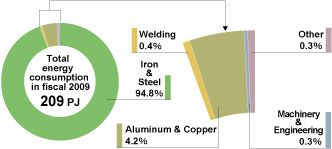
Iron and Steel Sector
| After the oil crises of the 1970s, we continued to promote energy savings through initiatives such as continuous and shortened processes and more effective energy usage through measures such as the installation of waste-heat recovery facilities all the way through to the 1990s. Since 2000, we continued with initiatives such as expanding waste-heat recovery facilities and increasing efficiency and have been taking steps to effectively harness waste resources. As a result, we have achieved an energy saving of more than 30% compared with figures for the early 1970s, even in spite of increases in energy consumption for purposes such as adding value to our products and stepping up environmental measures. During fiscal 2009, both energy consumption and CO2 emissions fell by approximately 7% year on year as a result of reduced production, with CO2 emissions down by 12% compared with fiscal 1990 levels. In spite of a marginal year on year increase due to significantly reduced production, energy consumption and CO2 emissions per metric ton of goods produced have also improved by approximately 12% compared to fiscal 1990 levels. Although energy consumption and CO2 emissions are likely to increase due to recovering production from fiscal 2010 onwards, we will nonetheless make every effort to meet our targets through initiatives such as improving process-specific operations and installing high-efficiency gas turbines at the Kakogawa Works, whilst also taking into account the bigger picture and factors such as the Kyoto mechanisms. |
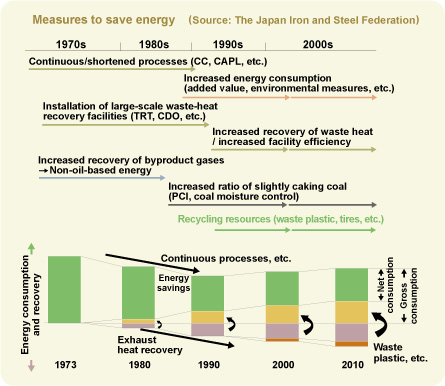
Trends in energy consumption and specific energy consumption (Approximate figures)
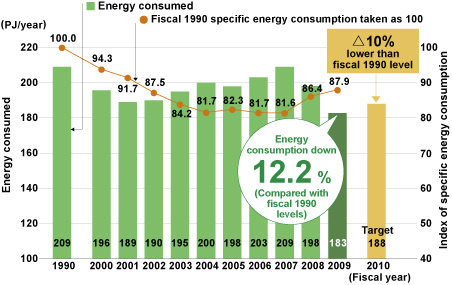
Trends in CO2 emissions and specific CO2 emissions index (Approximate figures)
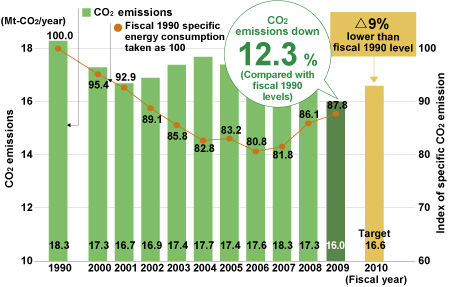
| Notes: | Aggregate figures for the Iron and Steel Sector, including coke production. Approximate figures based on Comprehensive Energy Statistics (calorific values) and National Greenhouse Gas Inventories (emission coefficients) Fiscal 2008 emission coefficient used for fiscal 2009 due to nondisclosure of fiscal 2009 coefficient for purchased electricity |
Aluminum and Copper Company
| At the Aluminum and Copper Company's Moka Plant, Chofu Works and Daian Plant manufacturing bases, we are in the process of gradually switching fuels from oil, LPG and other oil-based fuels to natural gas. In parallel with this process, we are also taking steps such as improving the efficiency of combustion facilities and increasing waste-heat recovery. In fiscal 2009, CO2 emissions fell by more than 10% compared to the previous year due to significantly reduced production. Energy consumption per metric ton of goods produced on the other hand was seriously affected by reduced production and increased by approximately 3%. We will continue to take steps such as promoting alternative fuels, improving combustion efficiency and fitting inverters to electric motors in order to keep on reducing specific energy consumption in fiscal 2010 and beyond. |
Trends in CO2 emissions and specific energy consumption (Approximate figures)
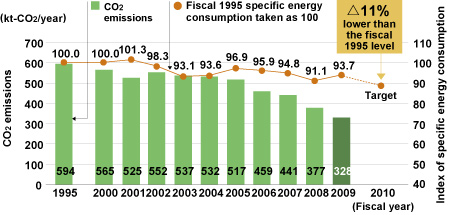
Machinery and Engineering Company
| The Machinery and Engineering Company has long since been committed to improving the efficiency of production facilities and improving energy efficiency through increased productivity. In spite of an increase in production, particularly energy-saving compressors, heat pumps and oil refining pressure vessels, we nonetheless managed to keep CO2 emissions at around the same level year on year through production efficiency initiatives and other measures. Although emissions were up slightly compared to fiscal 1997 (base year), CO2 emissions per unit of sales have improved by more than 30%. We will continue to improve production efficiency and increase the efficiency of individual machinery, air conditioning systems and other facilities in order to further reduce energy consumption and CO2 emissions in the future. |
Trends in CO2 emissions and specific energy consumption (Approximate figures)
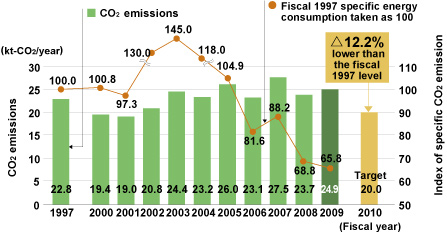
Welding Company
| As a result of energy-saving initiatives and improved efficiency at individual plants, the Welding Company has reduced CO2 emissions by more than 30% compared to fiscal 1990 levels. CO2 emissions also fell in fiscal 2009 due to significantly reduced production. Although production is expected to recover from fiscal 2010 onwards, we will continue work on saving energy in the future through specific operational measures such as reviewing compressed air and hot air loss within our plants, upgrading air conditioning systems and reviewing operating practices. |
Trends in CO2 emissions and specific energy consumption (Approximate figures)
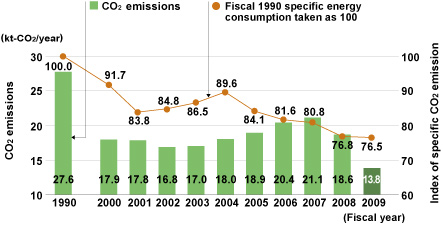
Business Associations' Voluntary Action Plans
|
Group Companies
| At Group companies, production processes are being improved, facilities are being upgraded, and measures are being implemented for more efficient energy use. |
Examples of Measures Implemented
|
Energy Savings in Logistics
| In addition to energy-saving initiatives and measures to combat global warming within manufacturing sectors, we also continue to systematically implement energy-saving initiatives as part of our logistic operations, including the transporting of raw materials from all over the world, in-house shipments, and shipping products. Other initiatives include using eco-friendly commercial vehicles and encouraging employees to commute to work via public transport. | 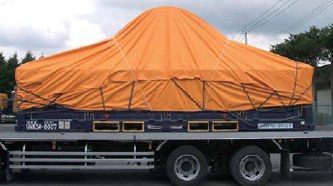 An open-top container being used to ship aluminum coils |
Iron and Steel Sector
| In partnership with raw material and product distribution subsidiary Kobelco Logistics Ltd., the Iron and Steel Sector continually strives to optimize product shipping routes and methods and upgrade shipping allocation and other logistic information systems in an effort to transport products as efficiently as possible. When shipping products over long distances, we use sea or rail as a rule and try to maintain organized shipping wherever possible so as to minimize urgent transportation by truck and promote modal shift. In conjunction with Nippon Steel Corporation and Sumitomo Metal Industries, Ltd., we run joint operations in domestic waters in order to reduce the number of journeys and are also working to increase load efficiency by carrying combined loads to distant locations. As a result of such initiatives, 97% of goods transported over distances of 500km or more during fiscal 2009 were transported by sea or rail. We will continue to promote modal shift and improve load efficiency in the future in order to ensure that items are shipped as efficiently as possible. |
Aluminum and Copper Company
| The Aluminum and Copper Company is actively promoting modal shift in terms of product shipments. Having been accredited as a Green Transportation Partner Project subsidized by the New Energy and Industrial Technology Development Organization (NEDO) in fiscal 2007, the Moka Works continues to expand container transportation and has switched modes of transport from trucks to open rail containers for selected products shipped to Kyushu and Osaka. At the Chofu Works, we are increasingly using ferries and rail containers to ship items by separating only freight pallets from trailers on longer distance routes, such as to the Kansai, Chubu and Kanto regions instead of trailers, in an effort to increase the rate of modal shift. Elsewhere, we are continuing to focus on improving load efficiency by combining loads for truck shipments at the Daian Plant and all other premises and on increasing transport efficiency by using larger vehicles. |
Machinery and Engineering Company
| In addition to existing modal shift initiatives involving shipping large products by rail or sea, we have also increased the load efficiency of shipping by truck, by using mixed loads and combining loads on chartered runs, in an effort to save energy as part of our logistics operations. At the Harima Plant meanwhile, we continue to recycle cardboard packaging so as to reduce environmental impact. |
Welding Company
| The Welding Company continues to promote modal shift through initiatives such as shipping products to distant locations via rail instead of truck. The Company has also made improvements such as advising drivers of company vehicles and other vehicles entering its premises to turn off their engines when stopping. |
Group companies
| Group companies are taking measures to make transportation more efficient. |
Examples of Measures Implemented
|
| Kobelco Logistics Ltd. is working to reduce fuel consumption by reducing ship turnaround times, through initiatives such as keeping demurrage times to a minimum and reducing loading and unloading times at the Kakogawa Works and Kobe Works. It has also installed facilities to supply waiting ships with electricity (land power facilities) at its Kansai and Kanto logistics centers, as well as at the two aforementioned works. This enables ships' onboard oil-powered generators to be shut down, which helps save energy and reduce NOx and SOx emissions. |
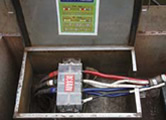 Shore power equipment 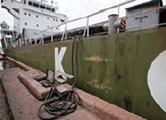 Supplying electricity to ships from shore |


